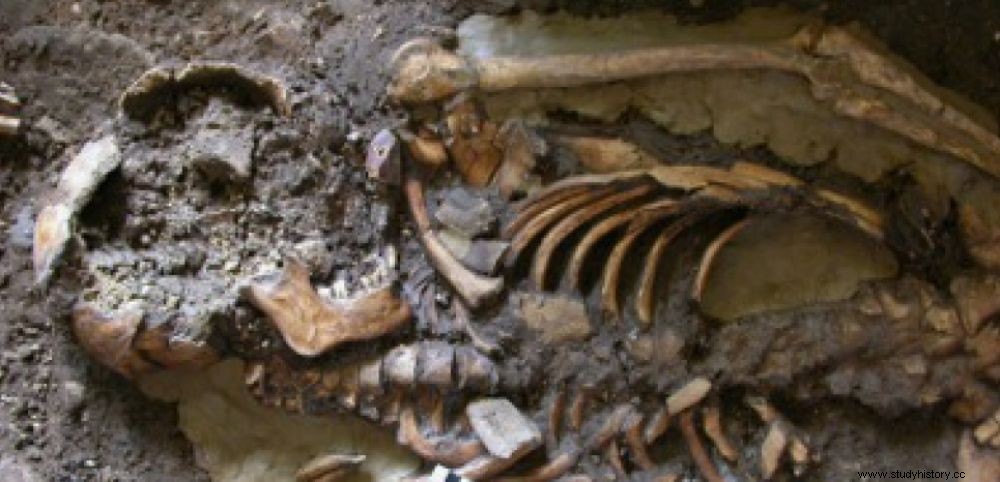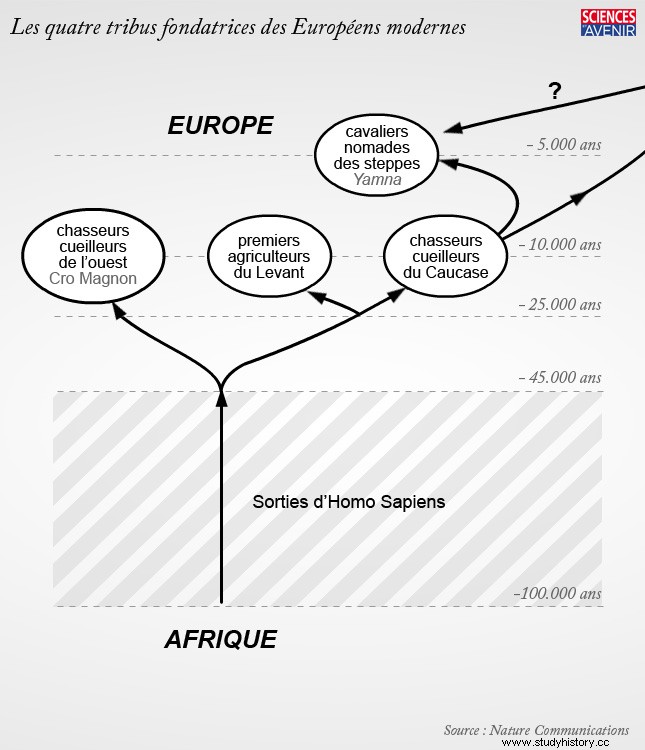 One of the fossilized bodies from Caucasus, Georgia.
One of the fossilized bodies from Caucasus, Georgia. ANALYSIS. Each of the seven billion humans living today on the planet is descended from groups of Homo sapiens out of Africa (see infographic) , show DNA analysis. But how did the population of modern Europeans come about? New genetic analyzes carried out on fossil men from the Caucasus, in Georgia, reveal that an as yet unknown group of hunter-gatherers contributed to their genetic heritage. This brings to four the number of "tribes" or rather human clades (group of living or extinct organisms descended from the same ancestor) identified to date and having contributed to the "gene pool" of Europe (read special issue n°183 "The great history of humanity" ). An international team – including Trinity College in Dublin, Ireland and the University of Cambridge in Great Britain – has indeed analyzed the bones of a man from the site of Satsurblia, aged -13,300 years (in the Upper Paleolithic, "the 'old stone age') and a man from the cave of Kotias -9700 years old, (in the mesolithic 'middle stone age'). She compared it with the DNA of a prehistoric Swiss man of the Cro-Magnon type from the Bichon cave, -13,700 years old, belonging to the group of hunter-gatherers from the west (see infographic). The results published in the journal Nature Communications shed light on the complex genetic history of the settlement of the old continent.
Hunter-gatherers, farmers and riders of the steppes
"A group of hunter-gatherers from the east first diverged genetically 45,000 years ago from a group of hunter-gatherers who went west and to which the famous Cro-Magnon of Dordogne belongs “, explains the geneticist Daniel Bradley, of Trinity College. The story does not end there. birth to a group of first farmers as well as to this famous group of hunter-gatherers of the Caucasus whose very homogeneous genetic signature we have just identified" . And for good reason, these men remained isolated for a long time while the ice age reached its peak between -25,000 and -23,000 years ago. These European groups experienced varying fortunes and conquests.
The "hunter-gatherers of the west", i.e. the "number 1 tribe", whose genetic signature has been identified by several DNA analyzes carried out over the last decade, settle from Spain to Hungary. The first Neolithic farmers - or tribe number 2 - successfully colonized the east and the Mediterranean, the domestication of plants and plants contributing to their demographic success. So much so that one could believe, for a time, that we Europeans were all descended from these Neolithic farmers. Around -7500 years ago, they spread widely, even replacing all the populations of hunter-gatherers encountered in the south. On the other hand, in the north, around - 4000 years ago, they mix their genes with those of the last hunter-gatherers of the west show an Irish study from 2012 and a German study from 2013.

Meanwhile, around -5000 years ago, a third tribe surged from the east:the Yamna, nomadic horsemen from the steppes and probably from an ancient line of hunter-gatherers who had gone east. These Early Bronze Age men, who likely spread Indo-European languages also contributed significantly to the gene pool of Europeans, mingling with all the farming cultures they encountered locally, shows a large June 2015 study conducted by the University of Gothenburg. But, what about, in this great mix, the new group of "Caucasian hunter-gatherers" identified, the "number 4 tribe"? "She did not stay forever living in self-sufficiency confined to her mountains", explains David Lordkipanidze, national director of the Georgian National Museum (see Sciences et Avenir n° 814 ) and co-author of the study published in Nature Communication. It survived the Ice Age and probably expanded as soon as the ice caps disappeared and allowed greater movement of people. The latest analyzes show that these hunter-gatherers from the Caucasus have also bequeathed their genes to modern Europeans and that they have above all largely contributed to founding the horse-riding tribe of the Yamna. Even stronger, the small group from the Caucasus exported its genes even further east, to India where it could still have distant descendants.
